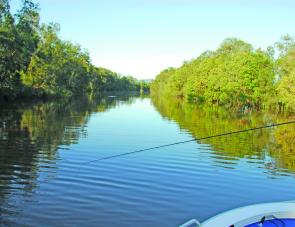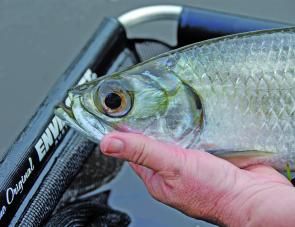This time of year is what I call the season in between. Tuna and other summer pelagic species have most likely deserted their inshore summer haunts and it's just a little too early for the likes of tailor, trevally, bass and other cooler season species to be reliable starters. So for me it's back to the creeks, rivers and lagoons for a crack at the good old tarpon.
Ernie Grant outlines tarpon as a fish found along the entire Queensland coast and attaining a length of 1.5m, but he does point out that catches in excess of 1.2m are not common. This is perhaps a good thing because tarpon are one fish that can pack a punch well above their weight. I've had a 50cm tarpon snap a 5kg b/s leader on the take, and I saw the fish coming, it didn't blindside me!
Most times – note those words – most times, tarpon are willing starters, not merely taking a fly but seemingly attacking it when in the mood. This will usually be in the first couple of hours of light or last bit of daylight in the tidal creeks and lagoons, with feed times extending in saltwater. They will also report for duty around lighted pontoons, jetties, and marinas at night.
Tarpon are widely spread and yet are often not widely recognised as specific inhabitants of an area. They don't grace the table well and are not often targeted specifically as a sportfish like jacks, trevally and other fish sometimes found with them. Yet, virtually any creek, backwater, upper river section, or canal could well have a resident population.
There are plenty of tarpon in the uppermost fresh or brackish sections of all south Queensland rivers, such as Brisbane, Logan, Albert, Coomera and Nerang. My view is that any area reached by tidal flow and inhabited by mullet will most likely have a population of tarpon in hand. Creeks and waterways adjoining the Pumicestone Passage area are also excellent tarpon habitat.
However, pristine waters are not always a precursor as I have seen tarpon surface rolling in the Logan River at Skinners Park. Nevertheless, in my opinion this section of the Logan lacks the necessary clarity for taking tarpon on fly. Further up, or maybe into the Albert River’s upper reaches things are quite different and generally worth the effort.
Tarpon are renowned for punching well above their weight class, so trout gear is really going to be earning its keep. A 6wt rod with a good stiff action would be a starting point and I'd even advocate a 7wt if good sized fish, 50cm+, are the norm for the area.
Your chosen reel should be able to handle brackish water without detriment. There is also nothing wrong with using a quality reel and line normally used in freshwater and giving the whole lot a wash down after use.
A full floating line is useful right on first light or dusk. A sink tip or an intermediate sink rate line is better once the fish stop their surface rolling, which seems to be a typical tarpon thing. One of the indicators of tarpon in a waterway is the surface rolling caper that sees them gulp air, show an enticing amount of dorsal fin and then move off leaving a bubble trail as an indicator of their position.
The bubble trail is a great place to direct the next cast to, but in reality it won’t always result in a hook up. However, at other times as the fly is wrenched straight off the leader as soon as it lands. These fish tend to take the fly as they turn and seldom give any indication that they are on the attack. And that's tarpon all over; sometimes they are violently on the job, other times they are far less willing, but if it's light tackle sport you want with your fly rod they are certainly hard to beat.
I've outlined where you might find tarpon, their likable trait of rolling on the surface, and what might happen when one takes a shine to the fly. But what if the fish are not moving at all on the day? The clue is to cast to snags or cover overhanging the water and sooner or later a fish will connect.
Hooks need to be very sharp; these fish have a rock hard mouth yet setting the hook hard into a fish, on the take, will usually result in a popped off fly unless quality leader is on the tip. It’s trial and error linked to experience, but I seldom fish under 5kg leader for tarpon.
Flies that imitate small fish, prawns, or surface flies, such as poppers or sliders are all great on tarpon. A size 1 or 2 hook is about the right size.
I've taken tarpon on flies such as small Deceivers and silver Crazy Charlies on numerous occasions, and a popper made from a tiny bit of foam or cork with flash material behind the head will certainly bring strikes. But remember with poppers there can be plenty of strikes but not a lot of hook ups. It's still fun, of course.
Tarpon have great eyesight and can locate a fly very quickly once it hits the water so the trick is to be ready.
Bony and with soft mushy flesh tarpon just don't grace the table well so the best thing is to release them for another day.
Reads: 5771
Sunrise is a great time to be on the water; note the tarpon rolling ahead of the boat.

There are two tarpon rolling in this shot. Shaded edges are where we can expect to find fish once the sun is well up.

Few fish have eyes as large as tarpon which means they get onto the fly very quickly if in the mood.

With release after capture in mind, the Environet helps reduce damage to scales.




